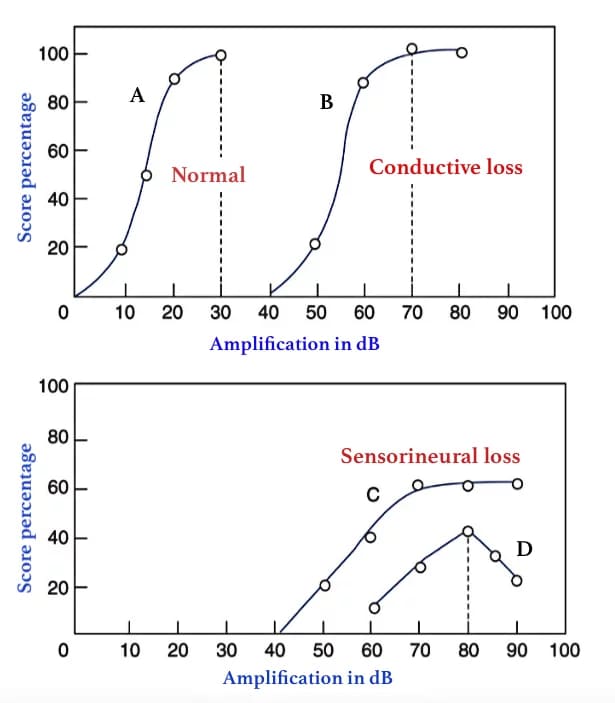Speech audiometry. It is a fundamental tool used to measure the patient’s hearing ability and comprehension of spoken words. The results are plotted on a graph. This test also aids in the detection of retrocochlear pathology and non-organic hearing loss.
Two parameters are studied in speech audiometry:
1. Speech reception threshold
2. Discrimination score.
- Speech Reception Threshold (SRT) or Speech-awareness threshold (SAT) is defined as the lowest speech intensity at which the patient correctly repeats or detects 50% of the words. Spondee words (two-syllable words with equal stress on each syllable such as pancake, hardware, playground) are delivered in the form of recorded tapes or monitored voice through the headphone of an audiometer or free field through speakers in a soundproof room. Spondees are easily understandable and contain information within each syllable that allows reasonably accurate guessing. The intensity is varied in 5 dB steps till half of them are correctly heard. In a normal adult, SRT is within 10 dB of pure tone average (500, 1000 and 2000 Hz). SRT better than pure-tone average by more than 10 dB suggests a functional hearing loss or unreliable pure tone audiogram.
- Speech discrimination score/ speech recognition/ word recognition score. It measures the patient’s ability to understand speech. A list of 25 – 50 phonetically balanced words (single-syllable words, e.g. pin, sin, day, bus) is delivered to each ear separately at 30–40 dB above his SRT, through pre-recorded material played from a computer/ CD and the percentage of words correctly heard by the patient is recorded. In normal persons and conductive hearing loss, a high score of 90–100% is achieved.
Table : Ability to understand speech and its relation to speech discrimination (SD) score. A list of 50 PB words is presented and the number correctly heard is multiplied by 2 the number
| SD score | Ability to understand speech |
| 90–100% | Normal (Excellent) |
| 76–88% | Slight difficulty (Good) |
| 60–74% | Moderate difficulty (Fair) |
| 40–58% | Poor |
| <40% | Very poor |
Patients with conductive deafness show improved recognition scores when the speech signal intensity is increased. Patients with sensorineural deafness usually do not improve their recognition scores with increasing intensity because increasing loudness distorts speech signal. Patients with retro-cochlear pathology may show a reduction of recognition scores with increasing intensity, a phenomenon described as the ‘rollover’ effect. The effect refers to the distortion in word recognition seen at high volumes, suggestive of eighth cranial nerve lesion. With increase in speech intensity above a particular level, the PB word score falls rather than maintain a plateau as in the cochlear type of sensorineural hearing loss.
Performance Intensity Function for PB Words
PB Max: It is better to plot PB scores against various levels of speech intensity on a chart and find the maximum score (PB max) a person can attain, instead of using a single suprathreshold intensity of 30–40 dB above SRT. The intensity of sound is noted at which PB max is attained. Maximum volume of hearing aid must be less than PB max.

Benefits of speech audiometry :
- To measure the speech reception threshold which determines actual disability & not hearing impairment.
- To differentiate organic from nonorganic(functional) hearing loss.
- To find the intensity at which a hearing aid/cochlear implants fits and assessing rehabilitation outcome.
- To differentiate a cochlear from a retrocochlear sensorineural hearing loss.
——— End of the chapter ———
Learning resources.
- Scott-Brown, Textbook of Otorhinolaryngology Head and Neck Surgery.
- Glasscock-Shambaugh, Textbook of Surgery of the Ear.
- Logan Turner, Textbook of Diseases of The Nose, Throat and Ear Head And Neck Surgery.
- Rob and smith, Textbook of Operative surgery.
- P L Dhingra, Textbook of Diseases of Ear, Nose and Throat.
- Hazarika P, Textbook of Ear Nose Throat And Head Neck Surgery Clinical Practical.
- Mohan Bansal, Textbook of Diseases of Ear, Nose and Throat Head and Neck surgery.
- Anirban Biswas, Textbook of Clinical Audio-vestibulometry.
- W. Arnold, U. Ganzer, Textbook of Otorhinolaryngology, Head and Neck Surgery.
- Salah Mansour, Textbook of Comprehensive and Clinical Anatomy of the Middle Ear.
- Susan Standring, Gray’s Anatomy.
- Ganong’s Review of Medical Physiology.
Author:

Dr. Rahul Kumar Bagla
MS & Fellow Rhinoplasty & Facial Plastic Surgery.
Associate Professor & Head
GIMS, Greater Noida, India
msrahulbagla@gmail.com
